-- Brad Friedman, The BRAD BLOG
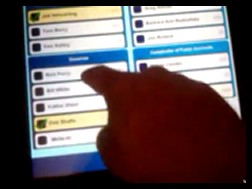 Aaaand here we go again. Our first report of touch-screen vote flipping of the year during early voting. And, for an added twist, this time it's Texas Republican Gov. Rick Perry who seems to be getting screwed by the 100% unverifiable ES&S iVotronic touch-screen voting system in question.
Aaaand here we go again. Our first report of touch-screen vote flipping of the year during early voting. And, for an added twist, this time it's Texas Republican Gov. Rick Perry who seems to be getting screwed by the 100% unverifiable ES&S iVotronic touch-screen voting system in question.
Most such reports of touch-screen vote-flipping or vote-hopping, historically, have been from Democratic voters seeing their votes flip to candidates of other parties, though there have been isolated reports over the years of Republican voters experiencing the very same problem. Indeed, another report has been published today from a voter in Collin County, TX, who says his vote flipped from Democratic gubernatorial candidate Bill White over to the Republican Perry.
The Dallas incident was posted as a YouTube video by programmer Don Relyea and began to go viral early this morning, before being set to "private," presumably by Relyea, at YouTube a few hours ago. So, unfortunately (for now), we're unable to show the video itself, though we watched it several times this morning before it was made unavailable, and have a step-by-step analysis of precisely what is seen in the video, as detailed by an Election Integrity expert who reviewed it a number of times to explain what is actually seen in it.
The removal of the video, seemingly shot via a cell phone camera, may be due to Texas law barring recording equipment of any kind in polling places. Dallas County Elections Administrator Bruce Sherbert told The BRAD BLOG that he has now referred the matter to the District Attorney for investigation, not due the purported incident of vote-flipping, but rather due to Relyea's video-taping of the event.
Sherbert's explanation for what is seen in the video, however, downplays the purported problem and does not appear to sync up with what is actually seen in the video supporting Relyea's contention that his attempted vote for Perry was being inappropriately flipped to a number of Green Party candidates on the ES&S iVotronic system...
He said, he said, and what the video said...
In short, Relyea's attempt to vote for Perry for Governor is seen resulting in a vote not only for Green Party gubernatorial candidate Deb Shafto, but also for a number of other Green Party candidates elsewhere on the ballot, as if the system had selected the option for a straight ticket Green Party vote across the board when the screen selection for Perry was touched.
Sherbert's explanation is that Relyea's thumb, seen just above the selection for Shafto when he is purportedly attempting to vote for Perry, is the culprit.
"The video most clearly indicates to me that it was an attempt to make it appear the Green Party was highlighted, because the thumb was right there at the Green Party position," Sherbert told us by phone today.
But Sherbert's response fails to explain why all the other Green Party candidates appear to light up at the exact same moment Relyea is seen attempting to select his choice for Perry. When pressed for further explanation on the additionally highlighted selections, Sherbert said he didn't notice that in the video and would not be having any further comment on the specifics of what is seen in the video itself.
Sherbert also questions the veracity of Relyea's story as a whole, saying that he believes "it looks very questionable." He says that pollworkers at the early voting location at the Audelia Library in Dallas all denied being informed about the incident. "No one said this happened," Sherbert explained. "If, as he said, he was moved to a different machine, no one says that happened from talking to all of our workers at the polling place."
Sherbert confirmed that Relyea did, in fact, vote at the Audelia Library in this election. He also confirmed, by reviewing his voting history at our request, that Relyea voted in the last four general elections, beginning in 2002, but that he hasn't voted in any primary elections, so it's impossible to determine his party leanings. Texas does not require voters to specify their party preference when registering to vote and they have an open primary system allowing voters to vote in any party's primary they wish.
Several attempts by The BRAD BLOG to contact Relyea have so far gone unanswered.
While the Election Administrator questions Relyea's account and says that recording the session is "blatantly against the law" in Texas, the video, if it accurately depicts what happened during his attempt to vote, is very similar to the reported experiences of many other voters across the nation over the last several election cycles since touch-screen voting has permeated the nation's democracy. (And a note: video-taping one's own voting experience is not illegal in many jurisdictions and has, in fact, proven enlightening and useful to officials in many cases including our own experience in the 2008 CA state primary when the e-voting system in Los Angeles misprinted 4 out of 12 of our own votes. At the time, the Registrar of Voting/County Clerk of the largest voting jurisdiction in the nation was very thankful for our having recorded the situation, as it allowed him to quickly pinpoint and confirm the specific e-voting system failure. Though not a touch-screen machine, the e-voting system that botched our votes was also made by ES&S.)
Reported ES&S iVotronic Failure Mirrors Scores of Similar Cases...
At this hour, it's unclear whether Relyea's video is a hoax or not. Though if so, it's unclear who or what it is meant to benefit (or harm). And whether it is the work of a scammer or not, the reported incident mirrors many other similar --- and confirmed --- events in past elections.
The ES&S iVotronic is, perhaps, the Direct Recording Electronic (DRE, usually touch-screen) voting system most often reported to flip votes from one candidate to another, or to simply prove unable to allow voters to select their preferred candidate on the screen. That may be, of course, because the iVotronic is one of the most ubiquitous DRE machines in the nation as ES&S is the country's top supplier of e-voting systems. Similar 100% unverifiable DRE voting systems are still used, incredibly enough, in some 20% of the nation's jurisdictions as made by ES&S and a handful of other private corporations.
According to VerifiedVoting.org's database, as of 2008, ES&S iVotronic systems were still being used at polling places in Arkansas, Washington D.C., Florida, Indiana, Kansas, Kentucky, Missouri, Mississippi, North Carolina, New Jersey, Ohio, Pennsylvania, South Carolina, Tennessee, Texas, Virginia, Wisconsin, and West Virginia.
In Dallas County, as in many jurisdictions, voters are forced to use the the iVotronic DREs during the early voting period, though on Election Day voters there will be allowed to vote on verifiable (if not necessarily verified), optically-scanned, hand-marked paper ballots. (This highlights yet another reason, for those who've asked, why early voting is generally a terrible idea in locations where you are forced to use DREs instead of paper, as it's strictly impossible to verify that any vote has ever been recorded accurately as per any voter's intent during any election on any DRE system ever used anywhere in the nation.)
The huge rate of reported failure on iVotronic systems may also may be due to the fact that the company's "quality control" has been notoriously dismal over the years, as seen in this Emmy-nominated, but otherwise almost-completely-ignored 2006 investigative report revealing the machines were originally built in a Filipino sweat-shop where the entirety of quality control testing consisted of a "shake test." (Yes, that means precisely what it sounds like, the machines are shaken to see if there are any loose screws, and if not, they pass quality control tests!)
The ES&S iVotronics are also the very same systems which:
- Inexplicably reported the selection of Alvin Greene, an unemployed military vet who'd never campaigned and had no campaign website, as the "winner" over four-term state legislator and former Circuit Court Judge Vic Rawl to be this year's Democratic Party nominee for the U.S. Senate in South Carolina last June.
- Inexplicably lost a full 18,000 votes in Sarasota, Florida, in a 2006 special election in the 13th Congressional District between Christine Jennings (D) and Vern Buchanan (R). The Republican Buchanan was declared the "winner" by just 369 votes despite the thousands of missing votes in the Democratic stronghold county and even the Republican's own wife reporting a problem in her attempt to try and vote for him.
- Are used across much of Arkansas where thousands of votes for Republican candidates for the U.S. Senate inexplicably disappeared in the days following the primary election in Monroe County this past May.
In 2006 and 2008, scores of reports of vote-flipping, similar to the one by Relyea, occurred in WV, TN, TX, MO, PA, NV, and elsewhere as documented in story after story by The BRAD BLOG at the time.
Computer science and cyber-security experts also found these particular ES&S machines, in 2007, to be vulnerable to "serious" viral vote-flipping attacks among other problems, though the U.S. Elections Assistance Commission (EAC) has failed to take any action to decertify the systems at the federal level or even to properly notify election officials about the vulnerability.
While we've seen video of actual election-ready touch-screen machines flipping votes in previous elections --- one of the most noteworthy was this video, where a WV County Clerk in 2008 demonstrated how he'd corrected a screen "calibration problem" on the system, only to see the vote flip yet again on camera during the demonstration --- the latest example, if it proves to be legitimate, as posted to YouTube by Relyea in Dallas, may be the clearest captured to date during an actual election.
Vote for the Democratic Gubernatorial Nominee Also Reportedly Flipped
In their report on Relyea's video earlier today, Gawker notes another similar case reportedly taking place in a different Texas county on a touch-screen machine made by a different company for a different candidate.
In a comment left on Reddit in response to Relyea's Dallas video, user "KaitouKid" detailed his own similar problem in Collin County, TX, while trying to vote for Democratic gubernatorial candidate Bill White on a Diebold AccuVote touch-screen system...
Another difference was that mine took some convincing to let me vote for Bill White. Every time I would press it, it would select Bill White for a second, then switch to Rick Perry. I eventually did it enough times that it stuck.
Well, at least I hope it stuck. There's really no way of knowing how it recorded the vote, is there?
"KaitouKid" is absolutely right. There is "no way of knowing" if the vote was recorded accurately. It's strictly, 100% scientifically impossible to know.
What Happened and How Election Officials Rely on the Wrong "Solution"
Many who looked at Relyea's video on YouTube and via Reddit where the video became popular this morning have charged that Relyea actually touched the Green Party candidate with his thumb either by accident or due to some nefarious sleight of hand. Relyea responded on Youtube to the "thumb critics" by noting that even if he had touched the Green Party candidate with his thumb, it would not explain why several other Green Party candidates are seen as being selected at the very same moment.
It does appear, from a close examination of his video when it was still publicly posted, that selecting the Republican Party gubernatorial candidate, on this particular machine, resulted in a straight party ticket selection for all of the Green Party's candidates. Straight party votes have been a notorious problem on DRE systems over the years in a number of states that allow that type of across-the-board voting.
The problem here, if it happened as seen on the video, is most likely one of screen calibration, versus nefarious misprogramming by someone. There is no way to know that for certain, of course, particularly as these systems have proven so vulnerable to malicious manipulation in the past. But, as we've noted many times over the years, and as countless computer and voting system experts have pointed out, it is not necessary to actually change the value of the vote on the screen --- where it may be noticed by the voter --- versus inside the system, where it wouldn't be, if one was actually trying to manipulate the results of an election.
In other words, a good hacker wouldn't let the voter know that his/her vote has been stolen --- though a bad hacker, or a system failure might.
Most election officials --- and voting machine company flacks --- therefore, attribute these frequent occurrences to screen calibration issues. While that may be the accurate diagnosis in many such cases, the solution most often used prescribed to correct the problem is entirely inappropriate and damned dangerous.
Historically, after reports indicate the possibility of screen calibration problems, officials attempt to physically re-calibrate the system. That process generally involves special administrative access to the system while it's in "election mode," allowing for wholly inappropriate access to the system, and even votes cast so far, at a time that it is most vulnerable to manipulation.
[Update: A reader writes in to note that audit logs from June's inexplicable Democratic Greene/Rawl U.S. Senate primary in SC show that "5% (1 in 20) of Charleston County voting machines were recalibrated" during the election. See details here.]
As scientists who have examined these machines have found and explained to both The BRAD BLOG and via scientific analysis, over the years, such systems should immediately be removed and quarantined from service in response to such incidents, rather than be opened to potential manipulation or viral infection during the "re-calibration" procedure at the time the system is is most vulnerable to malfeasance.
That process, however, is rarely followed, and machines are routinely re-calibrated and put immediately back into service, allowing for even more questions to arise about the validity of the votes recorded on those machines and others that may be infected by a potential virus inserted during the process.
Here then is step-by-step description of Relyea's video --- uncorroborated as accurate, as it currently stands right now --- as compiled by long-time Election Integrity advocate Howard Stanislevic, detailing each screen as seen as the voter is seen touching the system...
2. Then he deselects the Repub for Congress, which seems to work as expected.
3. And he re-selects the Repub for Congress, which seems to work as expected.
4. Then he selects the Repub for Governor and he gets an overvote notification. This seems to be because his finger also touched the candidate just below the Repub in this same race.
5. Then he tries to re-select the Repub for Governor and at that point, the straight Green Party votes appear, except for the Repub for Congress selection, which is retained.
6. Next, he deselects Green Party.and we see the orginal screen again as in 1 above.
7. Then we see 2 above again: only the Repub for Congress selected.
8. Then he tries to select the Repub for Governor again, but without deselecting and re-selecting the Repub for Congress and without overvoting as he did in 2, 3 and 4 above respectively. This time no overvote notification, but an immediate straight Green Party vote except for the Republican for Congress, which is retained.
9. End of video.
Summary: Every time a vote is cast for the Repub for Governor, it results in a straight Green Party vote, except for the Repub for Congress (which is expected behavior), and when there is an overvote in the Gov's race (also expected behavior).
Possible explanation: The Republican for Governor is defined in the election configuration as the straight Green Party vote. The ballot text on the screen is meaningless (just as the text on a paper ballot would be meaningless if this were a scanner election).
If the above explanation is correct, an extensive source-code review would show that the source code is NOT the cause of this problem, but of course the code makes it possible (i.e., the machines are capable of vote-switching).


 Sunday 'Close Enough' Toons
Sunday 'Close Enough' Toons A Pretty Weak 'Strongman': 'BradCast' 10/30/25
A Pretty Weak 'Strongman': 'BradCast' 10/30/25 'Green News Report' 10/30/25
'Green News Report' 10/30/25
 Proposal for 'First Politically Viable Wealth Tax' Takes Shape in CA: 'BradCast' 10/29/25
Proposal for 'First Politically Viable Wealth Tax' Takes Shape in CA: 'BradCast' 10/29/25 Monster Storm, Endless Wars, Gamed Elections:
Monster Storm, Endless Wars, Gamed Elections: 'Green News Report' 10/28/25
'Green News Report' 10/28/25 Let's Play 'Who Wants
Let's Play 'Who Wants Sunday 'Cartoonists Dilemma' Toons
Sunday 'Cartoonists Dilemma' Toons Exiled NOAA Scientists Resurrect Critical Disaster Database: 'BradCast' 10/23/25
Exiled NOAA Scientists Resurrect Critical Disaster Database: 'BradCast' 10/23/25  'Green News Report' 10/23/25
'Green News Report' 10/23/25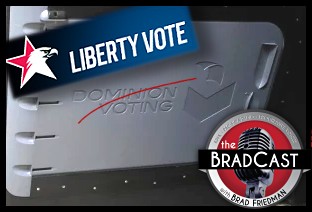 Trump-Allied GOP Partisan Buys Dominion Voting Systems: 'BradCast' 10/22/25
Trump-Allied GOP Partisan Buys Dominion Voting Systems: 'BradCast' 10/22/25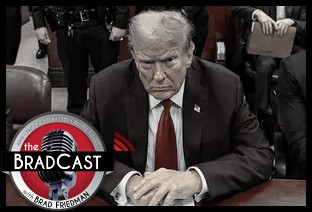 Trump, Republican Law(lessness) & (Dis)Order: 'BradCast' 10/21/25
Trump, Republican Law(lessness) & (Dis)Order: 'BradCast' 10/21/25 'Green News Report' 10/21/25
'Green News Report' 10/21/25 Celebrating 'No Kings': 'BradCast' 10/20/25
Celebrating 'No Kings': 'BradCast' 10/20/25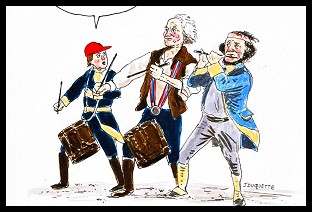 Sunday 'How It Started' Toons
Sunday 'How It Started' Toons SCOTUS Repubs Appear Ready to Gut Rest of Voting Rights Act: 'BradCast' 10/16/25
SCOTUS Repubs Appear Ready to Gut Rest of Voting Rights Act: 'BradCast' 10/16/25 'Green News Report' 10/16/25
'Green News Report' 10/16/25 The 'Epstein Shutdown' and Other Autocratic Nightmares: 'BradCast' 10/15/25
The 'Epstein Shutdown' and Other Autocratic Nightmares: 'BradCast' 10/15/25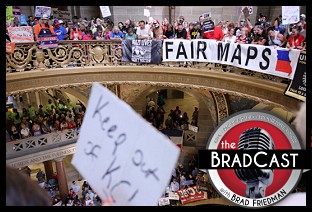 Group Vows to Block MO's GOP U.S. House Gerrymander: 'BradCast' 10/14/25
Group Vows to Block MO's GOP U.S. House Gerrymander: 'BradCast' 10/14/25 Trump Labor Dept. Warns Trump Policies Sparking Food Crisis: 'BradCast' 10/9/25
Trump Labor Dept. Warns Trump Policies Sparking Food Crisis: 'BradCast' 10/9/25 Trump's Losing Battles: 'BradCast' 10/8/25
Trump's Losing Battles: 'BradCast' 10/8/25 Trump, Roberts and His Stacked, Packed and Captured SCOTUS: 'BradCast' 10/7/25
Trump, Roberts and His Stacked, Packed and Captured SCOTUS: 'BradCast' 10/7/25 Trump Attempting His 'Invasion from Within': 'BradCast' 10/6/25
Trump Attempting His 'Invasion from Within': 'BradCast' 10/6/25 Biden Budget Expert: Mass Firings in Shutdown 'Illegal': 'BradCast' 10/2/25
Biden Budget Expert: Mass Firings in Shutdown 'Illegal': 'BradCast' 10/2/25 Why is DOJ Suing 'Blue' States for Their Voter Databases?: 'BradCast' 10/1/25
Why is DOJ Suing 'Blue' States for Their Voter Databases?: 'BradCast' 10/1/25
 VA GOP VOTER REG FRAUDSTER OFF HOOK
VA GOP VOTER REG FRAUDSTER OFF HOOK Criminal GOP Voter Registration Fraud Probe Expanding in VA
Criminal GOP Voter Registration Fraud Probe Expanding in VA DOJ PROBE SOUGHT AFTER VA ARREST
DOJ PROBE SOUGHT AFTER VA ARREST Arrest in VA: GOP Voter Reg Scandal Widens
Arrest in VA: GOP Voter Reg Scandal Widens ALL TOGETHER: ROVE, SPROUL, KOCHS, RNC
ALL TOGETHER: ROVE, SPROUL, KOCHS, RNC LATimes: RNC's 'Fired' Sproul Working for Repubs in 'as Many as 30 States'
LATimes: RNC's 'Fired' Sproul Working for Repubs in 'as Many as 30 States' 'Fired' Sproul Group 'Cloned', Still Working for Republicans in At Least 10 States
'Fired' Sproul Group 'Cloned', Still Working for Republicans in At Least 10 States FINALLY: FOX ON GOP REG FRAUD SCANDAL
FINALLY: FOX ON GOP REG FRAUD SCANDAL COLORADO FOLLOWS FLORIDA WITH GOP CRIMINAL INVESTIGATION
COLORADO FOLLOWS FLORIDA WITH GOP CRIMINAL INVESTIGATION CRIMINAL PROBE LAUNCHED INTO GOP VOTER REGISTRATION FRAUD SCANDAL IN FL
CRIMINAL PROBE LAUNCHED INTO GOP VOTER REGISTRATION FRAUD SCANDAL IN FL Brad Breaks PA Photo ID & GOP Registration Fraud Scandal News on Hartmann TV
Brad Breaks PA Photo ID & GOP Registration Fraud Scandal News on Hartmann TV  CAUGHT ON TAPE: COORDINATED NATIONWIDE GOP VOTER REG SCAM
CAUGHT ON TAPE: COORDINATED NATIONWIDE GOP VOTER REG SCAM CRIMINAL ELECTION FRAUD COMPLAINT FILED AGAINST GOP 'FRAUD' FIRM
CRIMINAL ELECTION FRAUD COMPLAINT FILED AGAINST GOP 'FRAUD' FIRM RICK SCOTT GETS ROLLED IN GOP REGISTRATION FRAUD SCANDAL
RICK SCOTT GETS ROLLED IN GOP REGISTRATION FRAUD SCANDAL VIDEO: Brad Breaks GOP Reg Fraud Scandal on Hartmann TV
VIDEO: Brad Breaks GOP Reg Fraud Scandal on Hartmann TV RNC FIRES NATIONAL VOTER REGISTRATION FIRM FOR FRAUD
RNC FIRES NATIONAL VOTER REGISTRATION FIRM FOR FRAUD EXCLUSIVE: Intvw w/ FL Official Who First Discovered GOP Reg Fraud
EXCLUSIVE: Intvw w/ FL Official Who First Discovered GOP Reg Fraud GOP REGISTRATION FRAUD FOUND IN FL
GOP REGISTRATION FRAUD FOUND IN FL

































